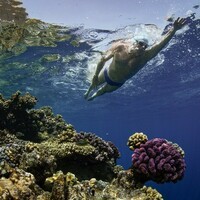Sighting is an important skill to develop for open water swimming. As the visibility may not be good and there will be no lane lines, you will need to lift your head regularly to see where you are going.
For breaststroke swimmers this is not much of a problem, as you will be looking forward every time you lift your head to breathe. For freestyle swimmers it will take a slight adaptation of your stroke to lift your head clear of the water.
As you should be aware from the technique section, lifting your head too much will cause problems for your body position, so you need to be able to do it as effectively as possible.
The key is to fit each lift of the head into the natural rhythm of your stroke and only lift as much as necessary.
There are 2 subtly different ways of doing this and it is worth experimenting with both
Sighting Method 1
1. As one arm extends and enters the water at the front of the stroke, begin to lift your head.
2. Press down with the leading hand to bring your face clear of the water.
3. You can take a breath at this point and orientate yourself at the same time.
4. Drop the head back into the water as the other arm recovers over the water. * This method has the advantage of enabling you to lift your head higher out of the water, but can have problems in choppier water where breathing to the front can be difficult.
Sighting Method 2
1. As your arm begins its’ recovery, take your breath at the normaltime.
2. Start to lift your head as the armbegins to enter the water.
3. Lift your head sufficiently to orientate, raising your eyes above the surface as the hand starts to press down.
4. Drop the head back into the water and continue with stroke cycle. * By taking the breath before sighting, it can make the action feel less rushed and also reduces the risk of getting a mouthful of water. However this option doesn’t allow you to gain the height of the first method.
How often should you be sighting to orientate yourself?
This can depend on several factors, but basically you need to be sighting often enough to be confident that you are swimming in the right direction, but not so often as to tire yourself out.
Factors that may affect how often you sight include:
• How difficult your target is to see
• How confident you are that you swim straight
• The difficulty of the conditions (sun, waves, cloud etc)
• Whether you are swimming in a group or with support
• How accurate you need to be for your target
• Whether you are swimming along a shoreline or into open water
So, if conditions are difficult or you are not confident you may need to sight every 3 or 4 breaths, to be certain that you are on course. However, if conditions are better or you can use others to help guide you, that number may increase upwards to10 or even 20 breaths.
But however confident you are it is prudent to get into the habit of checking your direction regularly.
What do you need to look for when you are sighting?
1. Use obvious and visible points of relief in the landscape
2. Choose highly visible permanent structures e.g. wind-turbines, pylons, buildings
3. Avoid basing you direction on objects that could move e.g. cars, moored boats
4. Objects low in the water may become obscured by waves or swell
5. Beware; distances can be very difficult to judge
6. If the sun is in your eyes it can make sighting difficult, so you may have to take visual cues from either side
7. Use any boat support and other swimmers to help you maintain your course
The prevailing weather conditions will have a massive effect on how you experience an open water swim. Unlike in a swimming pool where two similar length swims will be subject to roughly similar and constant conditions; two similar open water swims may be rendered unrecognizable by differences in the weather. Not only may conditions vary from swim to swim, it is not uncommon for conditions to change during an individual swim.
All weather conditions can cause hazards or difficulty, so, be aware of them and take them into account:
• Sunny – may affect visibility and increase risk of sunburn/sunstroke
• Fog – reduced visibility and muffling of sound
• Wind – can cause choppy conditions and waves. Also possibility of blowing you away from your course.
• Rain – may cause increased water flow and flooding
• Thunder/Lightning – obvious danger to anybody out in the open
Be aware of changing or deteriorating conditions, keeping one eye on the weather at all times. Make sure you have a plan for what to do if conditions worsen and that you can get out at short notice.
Part of the attraction of open water swimming is experiencing and taking on these varying conditions. Only swim in weather that you are comfortable with and feel adequately prepared and supported to cope with. If in doubt: stay out!
Goggles
The prevailing weather conditions and the position of the sun can combine to cause a wide range of light conditions at the water surface. This can compromise visibility if you don’t have appropriate eyewear.
It is worth investing in 2 pairs of goggles;
• 1 tinted pair – for bright or high glare conditions (morning/evening)
• 1 clear pair – for low light or overcast conditions
The sighting training technique information is an extract from the SwimTrek Open Water Swimming Training Plan and can be accessed for free by clicking here.










